List of rulers of the Netherlands
The Netherlands, or Low Countries, possessed clearly delineated boundaries only after 1500. Still in many respects they demonstrated common traits and underwent similar development that differentiated them from surrounding countries. The social, economic and political similarities evident throughout most of the region stem from the High Middle Ages, when the Scheldt, Maas and Rhine delta area became an important center of trade. Next to Northern Italy, the Low Countries became the most urbanised and prosperous region in Europe.
Its political system exhibited, from relatively early on, a degree of representative government that differed from the more feudal arrangements then existent in much of Europe. Internationally, the region served both as a mediator for and a buffer to the surrounding great powers, France, England, and Germany.[1]
Leaders of Frisii, Belgae, Canninefates and Batavi (before 400)
What little is known of the Frisii is provided by a few Roman accounts, whose province Germania Inferior shared a border with the Frisii. Frisii had elected chieftains who led by example rather than by authority.[2] Two Frisii kings, Malorix and Verritus, visited Rome to meet Nero.[3] The Frisii were bordered on the south by Germanic tribes living on Roman territory, and that would later coalesce into the Frankish confederation in the 3rd century, like the Batavi and the Cananefates. Tacitus mentions Gaius Julius Civilis as leader of the Batavi, and Brinno as leader of Cananefates. The coastal lands of the Frisii, Romans, Batavi and Cananefates were abandoned by c. 400 due to flooding caused by a marine transgression and lay empty for a century.
The Salii (Salian Franks) are one of the peoples who formed the foundation for early (both Northern- and Southern) Dutch culture, society and language since the fall of the Roman empire. After settling within the Roman territories, first in Germania Inferior and later in Gallia Belgica, they developed an organised society that developed the agriculture in regions that had become underpopulated. Merovech (d. 453/457) and Childeric I (c. 440 – 481/482) were Sallian chieftains before Clovis I (c. 466 – c. 511) united all of the Frankish tribes under one ruler. With the Roman Empire as an example, he replaced the form of leadership from a group of royal chieftains to a single king. He moved his court from Tournai in present-day Belgium, to Paris, and created the Frankish Kingdom.
For all Frankish kings, see: List of Frankish kings
Kings of Frisia (600–775)
After the Migration Period, the Frisian Kingdom emerged around 600 AD, north of the Frankish Kingdom. The Frisians consisted of tribes with loose bonds, and were not the same Frisii from Roman times. Under Redbad the Frisian kingship reached its maximum geographic development, covering most of the area of what is now the Netherlands and the coast in northern Germany. In 722 the Frisian land west of the Vlie (what is now Holland, Utrecht and Zeeland came in Frankish hands. In 734, in the Battle of the Boarn, the area west of the Lauwers (nowadays Friesland) resulted in a Frankisch victory and the end of the Frisian kingdom. Only the Frisians east of the Lauwers (Groningen and East Frisia) remained independent. In 772 they lost their independence as well.
| Name |
Lifespan |
Reign start |
Reign end |
Notes |
Family |
Image |
|---|---|---|---|---|---|---|
| Finn Folcwalding
|
ca. 500 | semi-legendary prince of Magna Frisia | .svg.png) |
|||
Audulf
|
ca. 600 | 627 | known from coins | .svg.png) |
||
Adgillis I
|
650/78 | .svg.png) |
||||
Redbad I
|
679/89 | 718/19 | son of Adgillus I | .svg.png) |
||
Poppo
|
719 | 734 | son of Redbad I; last king of the Frisians | .svg.png) |
Counts of Frisia (775–885)
In 775, Charles the Great made Frisia officially part of the Frankish Kingdom. The wars ended with the last uprising of the Frisians in 793 and the pacification of them. Counts were appointed by the Frankish rulers. However, Danish Vikings raided Frisia in the end of the 9th century and established Viking rule. After the division of the Frankish Kingdom in West Francia and East Francia, they gained more autonomy.
See also:
- Middle Francia (843–855)
- List of rulers of Lorraine
- Lower Lorraine (959–1190)
| Name |
Lifespan |
Reign start |
Reign end |
Notes |
Family |
Image |
|---|---|---|---|---|---|---|
Alfbad
|
749 | 775/786 | possibly son of Redbad | Frisia | .svg.png) |
|
| Nordalah
|
786? | 806? | son of Alfbad | Frisia | .svg.png) |
|
| Dirk
|
806? | 810? | Frisia | .svg.png) |
||
| Godfrey
|
807/08 | 839? | invader | Danish |  |
|
| Rorik
|
ca. 841 | ca. 873 | cousin of Godfrey; invader | Danish |  |
|
Gerulf I
|
before 839 | after 855 | son of Dirk or Nordalah?; reeve of the Frisians between Vlie and the river Weser | Frisia | .svg.png) |
Counts of Holland and West-Frisia (885–1433)
While the Frisian kingdom had comprised most of the present day Netherlands, the later province of Friesland in the Netherlands was much reduced. Already in the early Middle Ages West-Frisia (Frisia west of the Vlie) was not considered to be a part of Frisia anymore, and came to be known as Holland (present day provinces North and South Holland and Zeeland). Floris II was the first count who restyled his name from count of "West-Frisia", in count of "Holland".
Frisia Proper in medieval time therefore only included the middle and eastern part. The middle part (corresponding to the present day Dutch province of Friesland) was populated by free peasants who successfully resisted all attempts by feudal lords to subdue them, mainly the counts of Holland and the bishops of Utrecht. In the eastern part, local chieftains created their own states (within the Holy Roman Empire) in the late Middle Ages. They became a county after 1446 until 1744, after which it was incorporated within Prussia and later Germany.
The counts of West-Frisia ruled locally in the name of the archbishop of Utrecht, but over time, the counts of Holland came to dominate the bishopric of Utrecht. The archbishop of Utrecht governed the area on behalf of the Holy Roman Emperor, who saw is power diminished by the feudal system in which the counts and dukes ruled almost as sovereigns.
The counts of Holland tried frequently to increase their territory but apart from the acquisition of Zeeland during the 14th century they had no lasting success. Instead it became a part of the mighty medieval dynasties possessions, first Wittelsbach then Valois and thereafter Habsburg.
For local rulers in other fiefs that consolidated into the Burgundian Netherlands (1384–1482), see:
- Counts of Flanders (862–1384)
- Counts of Namur (981–1429)
- Dukes of Limburg (1065–1430)
- Counts of Hainaut (1071–1432)
- Landgraves and Dukes of Brabant (1085-1430)
- Bishops of Utrecht (1024–1456)
- Counts and Dukes of Luxembourg (1059-1443)
- Counts and Dukes of Guelders (1096–1543)
| Name |
Lifespan |
Reign start |
Reign end |
Notes |
Family |
Image |
|---|---|---|---|---|---|---|
| Gerulf II
|
ca. 885 | 895/896 | son or grandson of Gerulf I of Frisia, or the same Gerulf | Holland |  |
|
| Dirk I
|
896 | ca. 931 | son of Gerolf? | Holland |  |
|
| Dirk I bis
|
ca. 931 | 939 | son of Dirk I; count of Frisia | Holland |  |
|
| Dirk II
|
939 | 988 | son of Dirk I bis; count of Frisia | Holland |  |
|
| Arnulf
|
988 | 993 | son of Dirk II; count of Frisia | Holland | 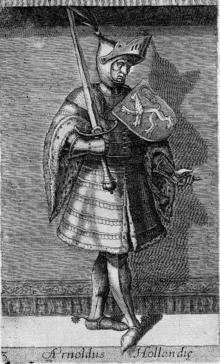 |
|
Dirk III
|
993 | 1039 | son of Arnulf; count of Frisia | Holland |  |
|
| Dirk IV
|
1039 | 1049 | son of Dirk III Hierosolymita; count of Frisia | Holland |  |
|
| Floris I
|
1049 | 1061 | brother of Dirk IV; regents: Gertrude of Saxony (widow of Floris I), Robert the Frisian (second husband of Gertrude) and Godfrey the Hunchback, Duke of Lower Lorraine; count of Frisia | Holland |  |
| Name |
Lifespan |
Reign start |
Reign end |
Notes |
Family |
Image |
|---|---|---|---|---|---|---|
Dirk V
|
1061 | 1091 | son of Floris I; count of Frisia | Holland |  |
|
Floris II
|
1091 | 1121 | son of Dirk V; first count who named himself count of 'Holland' | Holland |  |
|
Dirk VI
|
1121 | 1157 | son of Floris II | Holland |  |
|
Floris III
|
1157 | 1190 | son of Dirk VI | Holland |  |
|
Dirk VII
|
1190 | 1203 | son of Floris III | Holland |  |
|
Ada
|
1203 | 1203 | daughter of Dirk VII; ruled together with Louis I; no issues | Holland |  |
|
William I
|
1203 | 1222 | son of Floris III | Holland |  |
|
Floris IV
|
1222 | 1234 | son of William I | Holland | 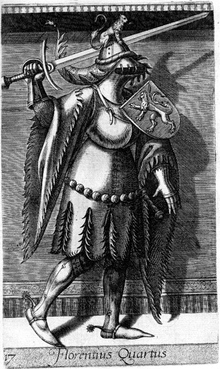 |
|
William II
|
1235 | 1256 | son of Floris IV | Holland |  |
|
Floris V
|
1256 | 1296 | son of William II; Floris de Voogd regent and guardian for Floris V (1256–1258) | Holland |  |
|
John I
|
1296 | 1299 | son of Floris V; John III, Lord of Renesse regent for John I (1296-1299); John II, Count of Hainaut inherited the county after John I's death | Holland | 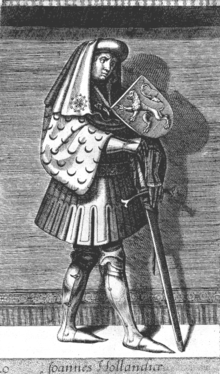 |
| Name |
Lifespan |
Reign start |
Reign end |
Notes |
Family |
Image |
|---|---|---|---|---|---|---|
John II
|
1299 | 1304 | son of John I of Avesnes | Avesnes |  |
|
William III
|
1304 | 1337 | son of John II | Avesnes |  |
|
William IV
|
1337 | 1345 | son of William III | Avesnes |  |
|
Margaret I
|
1345 | 1354 | daughter of William III; a.k.a. Margaret II of Avesnes, countess Margaret II of Hainaut | Avesnes |  |
| Name |
Lifespan |
Reign start |
Reign end |
Notes |
Family |
Image |
|---|---|---|---|---|---|---|
William V
|
1349 | 1389 | son of Margaret of Holland; a.k.a. duke William I of Bavaria, count William III of Hainaut, count William IV of Zeeland | Wittelsbach |  |
|
Albert
|
1389 | 1404 | son of Margaret of Holland; count of Holland, Hainaut, and Zeeland | Wittelsbach |  |
|
William VI
|
1404 | 1417 | son of Margaret of Brieg; a.k.a. duke William II of Bavaria-Straubing, count William IV of Hainaut, count William V of Zeeland | Wittelsbach |  |
|
Jacqueline
|
1417 | 1433 | countess of Holland, Zeeland and Hainaut; a.k.a. duchess Jacqueline of Bavaria-Straubing; no heir; With Jacqueline's remarriage to the English Henry of Gloucester, title passes to the dukes of Burgundy | Wittelsbach |  |
Counts of Burgundian and Habsburg Netherlands (1433-1581)
Burgundian dukes acquired a continuous territory covering most of modern-day Belgium and the Netherlands. By establishing the States General, Philip the Good centralised power, thereby laying the basis for the Netherlands as a single country with a common interest. The Burgundian dukes - and later the monarchs of Habsburg Spain - appointed stadtholders (place holders or deputies) in each one of its estates in the Netherlands. See: List of stadtholders for the Low Countries provinces
In the 16th century, Charles V of Habsburg Spain completed the process of consolidation by becoming the sole feudal overlord: Lord of the Netherlands (or Seventeen Provinces). In this political union, the stadtholders served under a governor-general, limiting their power and of the estates. See: List of governors of the Habsburg Netherlands
| Name |
Lifespan |
Reign start |
Reign end |
Notes |
Family |
Image |
|---|---|---|---|---|---|---|
Philip I
|
1433 | 1467 | a.k.a. Philp III of Burgundy | Valois-Burgundy |  |
|
Charles I
|
1467 | 1477 | a.k.a. duke of Burgundy, Brabant, Limburg, Guelder and Luxembourg, count of Flanders, Hainaut, Holland, Zeeland, Zutphen | Valois-Burgundy | 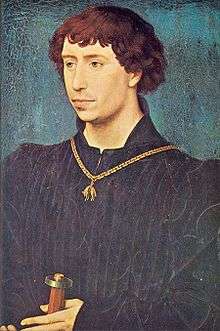 |
|
Mary
|
1477 | 1482 | daughter of Charles I | Valois-Burgundy |  |
| Name |
Lifespan |
Reign start |
Reign end |
Notes |
Family |
Image |
|---|---|---|---|---|---|---|
Maximilian I
|
1482 | 1494 | a.k.a. Holy Roman Emperor[4] | Habsburg |  |
|
Philip II
|
1494 | 1506 | a.k.a. king Philip I of Castile; son of Maximilian I | Habsburg |  |
|
Charles II
|
1506 | 1555 | son of Philip the Handsome; introduced title Lord of the Netherlands; a.k.a. Charles V, Holy Roman Emperor and king Charles I of Spain; regent: Maximilian I (1506 to 1515); governors-general: William de Croÿ (1504-1507), Margaret of Austria (1507-1530) and Mary of Austria (1531-1555) | Habsburg |  |
|
Philip III
|
1555 | 1581 | Lord of the Netherlands; a.k.a. king Philip II of Spain; son of Charles II of Spain; governors-general: Emmanuel Philibert of Savoy (1555-1559) and Margaret of Parma (1559-1567) | Habsburg |  |
The Seven United Netherlands (1581–1795)
Unhappy with the centralisation of political power to Habsburg Spain, seven northern provinces seceded into the Dutch Republic: Groningen, Frisia, Overijssel, Guelders, Utrecht, Holland and Zeeland. They kept parts of Limburg, Brabant and Flanders during and after the Eighty Years' War as Generality Lands.
Military control was given to a stadtholder who in theory was elected by the States-General of the Netherlands of the now independent Dutch Republic. The function was de facto hereditary in Holland and Zeeland, and held by the Prince of Orange. Drawn from a side branch of the House of Orange, Frisia and Groningen had a different stadtholder, until 1711. The following centuries saw the republic being co-ruled by the grand pensionary of the states-general and the stadtholders, with continuous power struggle between the offices.
See also List of Grand Pensionaries
The Southern Netherlands (Artois, Flanders, Brabant, Namur, Hainaut and Luxembourg) were restored to Habsburg Spanish rule. They became known as the Spanish Netherlands, and following the War of the Spanish Succession as the Austrian Netherlands.
For rulers in the Southern Netherlands after the secession of the northern provinces, see: List of governors of the Habsburg Netherlands
Rulers during the French period (1795–1813)
In the Northern Netherlands, the stadtholdership developed into a hereditary system, with increasing power accumulating to the stadtholder. Dutch Patriots sought a more democratic form of government. With French help they proclaimed the Batavian Republic (1795-1806). In 1806, Napoleon Bonaparte overturned the Batavian Republic. Napoleon established a client Kingdom of Holland with his brother as king (1806-1810). The Netherlands were subsequently annexed into the First French Empire (1810-1813). Stadtholder Stadtholder William V went in exile. The Southern Netherlands (Austrian Netherlands) including Prince-Bishopric of Liège were annexed into the French First Republic (1795–1804) and the First French Empire (1804–1815).
| Name |
Lifespan |
Reign start |
Reign end |
Notes |
Family |
Image |
|---|---|---|---|---|---|---|
Louis I
|
2 September 1778 – 25 July 1846 (aged 67) | 5 June 1806 (office established) | 1 July 1810 | Napoleon Bonaparte restyled the Netherlands into the Kingdom of Holland, putting his brother Louis I on the throne | Bonaparte | 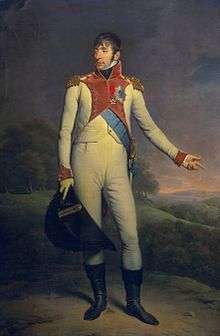 |
Louis II
|
11 October 1804 – 17 March 1831 (aged 26) | 1 July 1810 | 9 July 1810 (office abolished | son of Louis I | Bonaparte | .jpg) |
Kings of the Netherlands (1813–present)
After the First French Empire collapsed, the crown was offered to sovereign prince William VI, son of stadtholder William V. The Congress of Vienna reunited the Northern Netherlands with the Southern Netherlands into the United Kingdom of the Netherlands of which William became king. The newly appointed kings originally had extensive powers. Constitutional reforms in 1848 transformed the Netherlands into a constitutional monarchy under the rule of law, ending the factual rule of the monarchs. The monarchy under the rule of law continues to date See: List of monarchs of the Netherlands.
The Belgian Revolution led to the secession of the southern part into the Kingdom of Belgium. See: List of Belgian monarchs
The non-French speaking part of Luxembourg remained in a personal union with the Netherlands, until William III died, leaving only his daughter Wilhelmina as an heir. Luxembourg allowed inheritance of the crown by males only, hence breaking the personal union. See: List of monarchs of Luxembourg
| Name |
Lifespan |
Reign start |
Reign end |
Notes |
Family |
Image |
|---|---|---|---|---|---|---|
William I
|
24 August 1772 – 12 December 1843 (aged 71) | 6 December 1813 (office established) | 7 October 1840 | son of William V; prince then king of Principality (1813-1815), United Kingdom (1815-1830) and Kingdom of the Netherlands (1830-1840); a.k.a. grand duke of Luxembourg | Orange-Nassau | 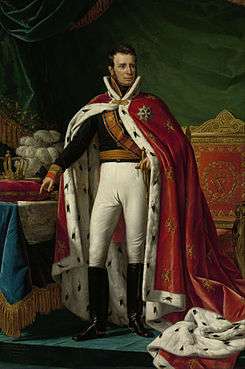 |
William II
|
6 December 1792 – 17 March 1849 (aged 56) | 7 October 1840 | 11 October 1848 | son of William I; a.k.a. grand duke of Luxembourg. Constitutional reforms turned the Netherlands into a constitutional monarchy under the rule of law in 1848 - William remained king until his death 17 March 1849. | Orange-Nassau |  |
See also
- Style of the Dutch sovereign
- Royal Standard of the Netherlands
- Line of succession to the Dutch throne
- List of heirs to the Dutch throne
- Inauguration of the Dutch monarch
References
- ↑ https://books.google.com/books?id=mBnCrZ_ogZQC&lpg=PP1&hl=en&pg=PP12#v=onepage&q&f=false
- ↑ Tacitus & 98:18–19, 23–24, 36–37, The Germany, Ch V, VII, XVI.
- ↑ Tacitus & 117:253, The Annals, Bk XIII, Ch 55. Events of AD 54–58.
- ↑ Established Habsburg rule in Spain by marrying his son Philip the Handsome to the future Queen Joanna of Castile.